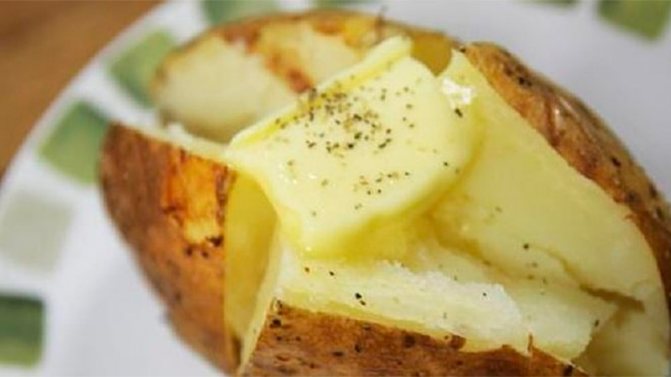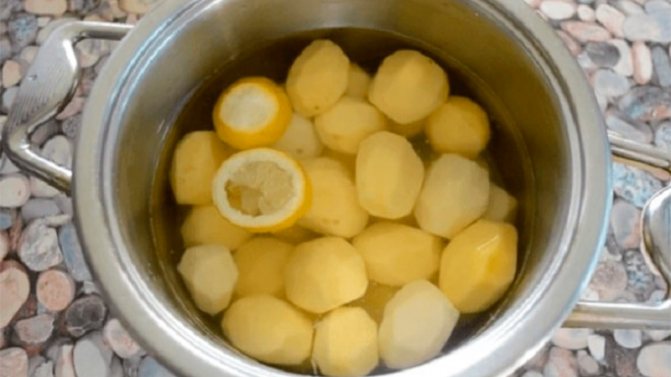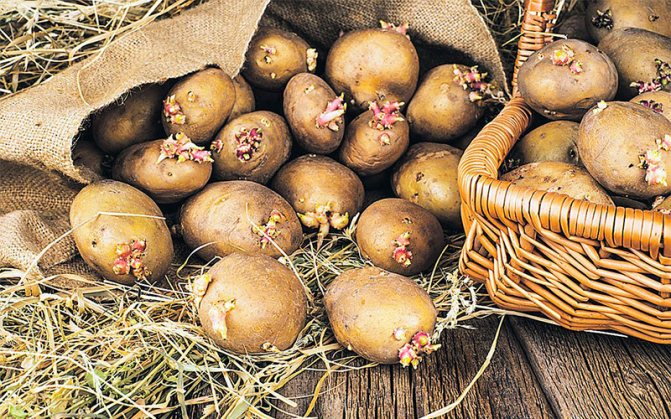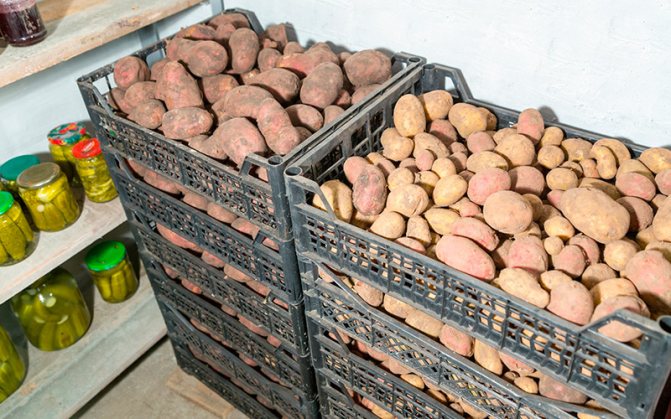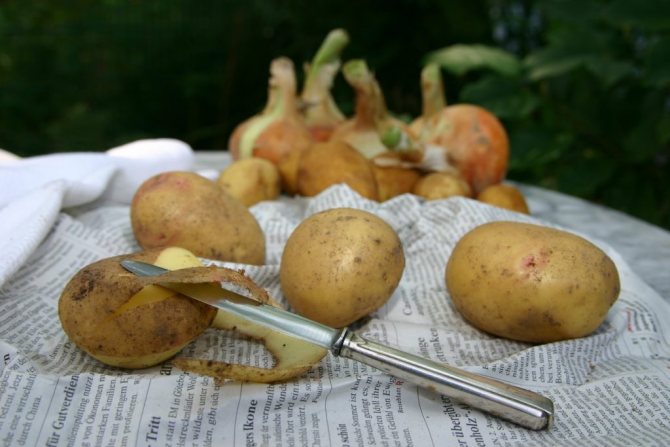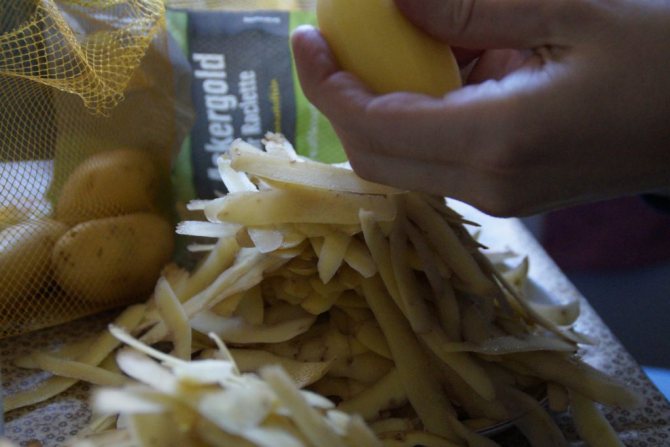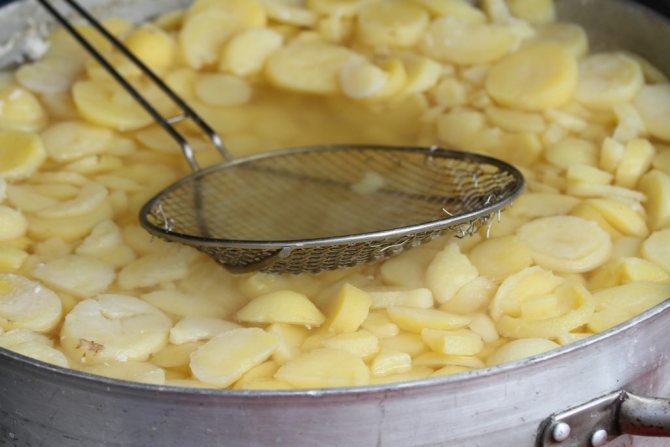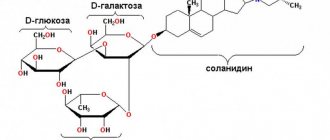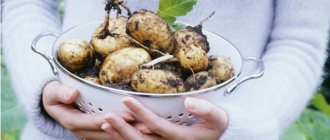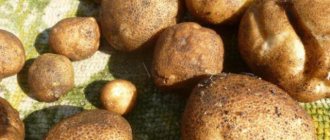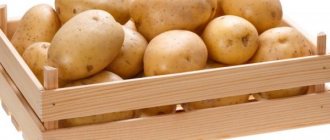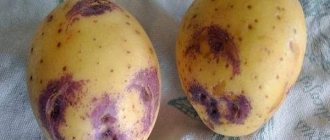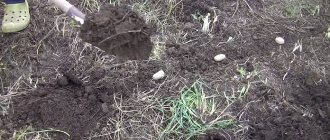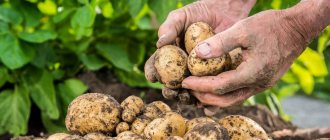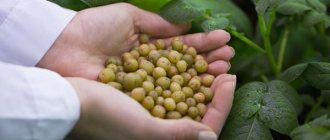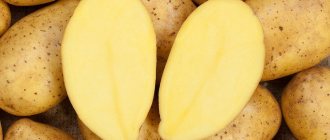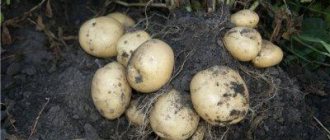Vegetable growing »Potatoes
0
1813
Article rating
The blackened potato inside is not a normal external pitchfork of the culture, normally it should not be. Most often, such spots appear due to the fact that mistakes were made during cultivation, as well as during storage of potatoes, however, it also happens that gray spot is a consequence of the development of a particular disease. We will understand in more detail why the potatoes turn black, and how to deal with this condition.
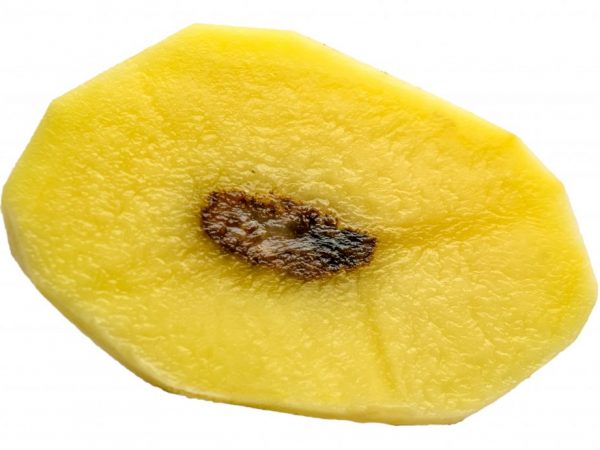
Causes of blackness inside potatoes
Reasons for browning potatoes after cooking
To calm down the housewives a little, consider why the potatoes darken after cooking and how to avoid this unpleasant appearance in the already boiled root vegetable.
Darkened potatoes are good for consumption and do not pose any health risks. The only downside is that the vegetable loses its taste and aesthetic appearance. There are many reasons why the root crop darkens after the decoction: this is also its improper storage or cultivation.
- During growth, the tubers lacked potassium. It is worth remembering that when fertilizing the soil under potatoes with potassium, chlorine must be avoided.
- When harvesting or transporting it, you must carefully monitor so that the root crop does not hit, which also threatens to darken the tuber after boiling.
- Potatoes turn black if they are slightly frozen (if the temperature in the room was less than +1 degrees during storage).
- After harvesting, all root vegetables must not be immediately lowered into the storage room. Previously, they are left in a cool, dry place before the onset of the first frost, so that the crop dries well and cools.
- The reason for the darkening of potatoes is not only the soil, which in its composition is not suitable for growing, but also the storage of the crop itself. The vegetable can suffocate from lack of oxygen in the basement or other room, which will also lead to darkening of the tubers.
- Compliance with the temperature regime during storage. Increased humidity leads to mold, which destroys oxygen. Seen wet tubers must be dried.
So that the potatoes do not darken in their future use and have an appetizing appearance, it is worth carefully studying and observing all storage rules.
Preventing browning of potatoes after cooking
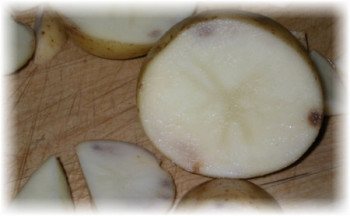

But what if a person is a city dweller, he does not have his own garden, he does not store potatoes, but makes all the supplies from the market and does not know how the root crop was previously grown, harvested and stored? The hostess who buys this vegetable on the market is not insured against purchasing low-quality potatoes, which will darken after cooking. But she can still use several rules to avoid this unpleasant incident.
- The first rule is to never buy a root crop in the cold season if the potatoes are wet. Such a root vegetable, most likely, was stored in a room with a low temperature, due to which it froze. Having thawed completely in a warm apartment, individual potatoes will begin to turn black even before cooking.
- The vegetable is peeled and placed in cold water for at least 10 minutes before cooking. Without water, the chemical compounds that are in the root vegetable will begin to oxidize from interaction with oxygen.
- The root vegetable is thrown into the pan only if the water boils or comes to a boil, while it should already be salted.
- Bay leaf helps to avoid darkening of potatoes after cooking. To do this, you just need to add a couple of leaves to the boiling potatoes.
- If the recipe for the dish allows you to add vinegar, then a tablespoon of it in 1 liter of water will also help the root vegetable retain its color.
- If potatoes are prepared for salads, you can add cucumber or cabbage pickle to hedge against darkening.
- From excess interaction with oxygen, the root crop is prepared so that the water completely covers all the tubers under a closed lid.
With the right choice of potatoes and the observance of simple rules in its preparation, this root vegetable is always ready to feed anyone deliciously. This vegetable is called the second bread, and for good reason: it deservedly took second place, because the variety of prepared dishes is simply amazing.
How to cook potatoes?
How to cook potatoes?
The product must be rinsed and cleaned before cooking. Potatoes are best placed in hot and salty water rather than cold water. So the product will save more vitamins and nutrients. The liquid in which the potatoes were boiled can be used to make vegetarian soups and broths. If cooked "in uniform", then the dish will be much healthier. But it should be borne in mind that solanine glycoside is present on the surface of the tubers and in the peel - this is a poisonous and bitter substance. If the potatoes are sprouted, then they must be carefully peeled. In the case when the product grows in fertilized soils, after cleaning it should be kept in cold water for about half an hour.
Why does the potato darken?
Probably, every housewife thought about why boiled potatoes turn black. The reason for this is chemical in nature. The tubers contain the amino acid tyrosine, which begins to oxidize and form the pigment melanin. It is he who dyes the potatoes dark. On an industrial scale, this problem is solved with the help of sulfur dioxide (sulfur dioxide), with which the product is treated. This substance has reducing properties. At home, potatoes can be dipped in boiled water and covered with a lid to prevent oxygen from entering.
How to avoid excessive softness of potatoes?
When boiling, the potatoes become soft due to the fact that the polymer molecules of protopectin are destroyed and pass into molecules of pectin, which is soluble. At the same time, magnesium and calcium cations are removed from the tubers. If the water is hard, this process is much slower. Therefore, potatoes must be added to dishes earlier than sour spices and foods, otherwise they will remain uncooked and tough. How to determine which potato will turn black? In an attempt to find an answer to the question of why potatoes turn black after boiling, you need to have an idea of the cause of this phenomenon. The browning after cooking is different from that which occurs on the raw product. There is a method that allows you to determine which tubers will blacken. To do this, you need to treat the potatoes with a solution of sodium nitrate, to which diluted hydrochloric acid is added, and then grease with caustic sodium. Within a few minutes, the treated area will start to turn red.
Are browned potatoes dangerous?
The housewives are interested not only in why the potatoes turn black during cooking, but also whether they are dangerous to health. Experts say that such a product can be safely eaten. Gardeners recommend keeping the correct proportions of fertilizers. The synthesis can be disrupted if there is a large amount of nitrogen, but little potassium. This will lead to an accumulation of proteins and amino acids. Therefore, it is worth taking care of a sufficient amount of potassium.To avoid darkening, you need to keep the potatoes in a dry and cool place until frost. Then the tubers will have time to dry and cool. If the product is immediately placed in the cellar, physiological changes will occur and the tubers will darken during cooking. In the event that this is impossible for some reason, it is necessary to hold the potatoes in cold water for some time before cooking.
Storage and ventilation
To understand why potatoes turn black after cooking, it will be useful to know the rules for storing it. Darkening can be caused not only by overconsolidated soil, but also by insufficient ventilation during storage. This leads to the fact that the potatoes do not have enough air, and they begin to "suffocate". To avoid this, it is necessary to regularly ventilate the room and carefully inspect the vegetables that are there. Do not store foods that have begun to rot or are damaged. Temperature readings and humidity also matter. Perspiration can cause rapid growth of mold, which absorbs oxygen. All wet tubers should be thoroughly dried. Harvesting and Transportation The answer to the question of why potatoes turn black after cooking may be non-observance of the rules of harvesting and transportation. When picking potatoes, you must not throw them away and allow them to get damaged. During storage, it is very important to ensure that the conditions are always optimal.
How to cook frozen potatoes?
If the product is frozen, it must be defrosted in cold water. When an ice crust forms around the potatoes, you need to change it and add a little salt. To make it easier to peel potatoes "in their uniforms", after boiling it is necessary to pour cold water over them. Secrets of cooking boiled potatoes Experienced chefs advise adding a little vinegar to the water while cooking potatoes. This will not only prevent browning, but will also help prevent the food from overcooking. Jacket potatoes will not boil over if you add a little more salt to the water than is required during normal cooking. Those varieties of potatoes that are considered mealy are often very boiled, so add pickle from cucumbers or cabbage to the water, and then a little more vinegar. It is better to cook such a product over low heat so that the starch swells evenly. One of the explanations for why boiled potatoes turn black may be that they are "old". In this case, a small amount of milk can be added during cooking. If the potatoes will not cook immediately after peeling, it is better to keep them in cold water, to which a drop of vinegar has been added. It should be salted at the beginning of cooking, so more vitamins and useful components will be preserved.
Where to keep peeled potatoes?
We have already figured out why the potatoes turn black after peeling. This is due to the fact that the compounds contained in the product interact with air, and this, in turn, causes the oxidation process. This can be avoided by pouring water over the roots with vinegar.
Housewives who buy vegetables in a store are often interested in why potatoes after or during cooking
covered
dark spots
... Wherein
darkens
not the whole tuber as a whole, but separate areas of blue-black color appear, similar to bruises. What can cause this phenomenon? Most often, they put forward a version about an excessive amount of nitrates and other chemicals, or are caused by improper storage of the vegetable. But, sometimes, exactly the same potato grows on its own garden plot, despite the correct agricultural technology.
How to prevent
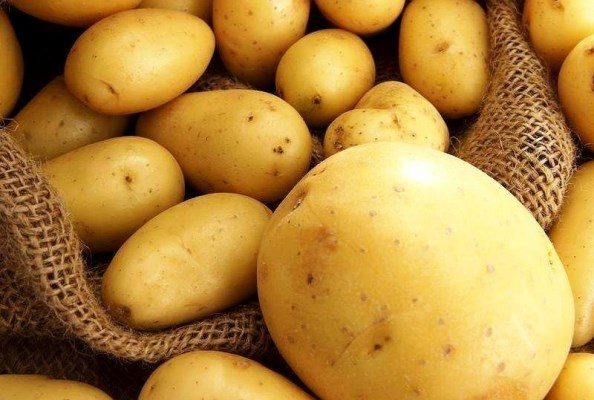

Let potatoes with black spots are not dangerous to health, but somehow they do not particularly cause an appetite. And her taste is not very good. It is not always possible to avoid an unpleasant situation, but it will not hurt to take some measures.
Owners of private houses always try to buy potatoes in reserve. But the residents of the apartment, at least for the coldest months, will not be superfluous to take care of this. Yes, buying good tubers in the winter is not a problem, but while you bring them home, they can freeze, which means there is a chance that they will turn black during cooking or frying.
It is imperative to wash the potatoes before peeling. Even if the root crops are pleasing to be visually clean, there is a risk that sellers have treated them with chemicals for longer storage. After removing the peel, the potatoes should not just be rinsed under the tap, but soaked for 10-15 minutes. Otherwise, on contact with air, a chemical reaction will occur and the potatoes will darken.
If the variety has a high starch content, it is necessary to soak it after cleaning not just in water, but in water with the addition of a couple of pinches of citric acid or several ascorbic tablets (the first option is still better).
It is necessary to put root crops in water only if it is already boiling well. It is recommended to pre-salt it.
Tip: Add a couple of lavrushka leaves to the water when boiling potatoes. This will help prevent browning. If you decide to fry the vegetable, it means that the seasoning must be put in the water in which it is soaked after cleaning.
Blackened potatoes are a grief for any housewife. But, now you know how to avoid this unpleasant situation. Use our tips and enjoy your cooking!
View Saved Recipes
main reason
Potatoes that change their color when boiled are quite common. And the sight of such tubers does not cause an appetite at all. The reason for dark spots on boiled potatoes is the lack of potassium in the fruit. The dark spots are explained as follows:
While still in the ground, potato tubers accumulate chlorogenic acid, which, during cooking, forms dark spots, combining with iron ions. Why doesn't the color change completely? This is explained by the fact that chlorogenic acid is unevenly distributed in the tuber. In the places of its greatest concentration, the very "bruises" appear. Normally, spots are not formed. This is prevented by citric acid formed under the influence of potassium in the tubers.
To solve this problem, it is possible to propose the introduction of chlorine-free potash fertilizers into the soil. If sand predominates in the soil, the fertilizers are washed out in a short time, it is preferable to fertilize with potassium as the potatoes grow.
Other reasons for browning potatoes:
- Deterioration in the quality of tubers also occurs when the soil is poorly saturated with oxygen (this is especially important during the active formation of tubers). This phenomenon is typical for clayey soils saturated with moisture.
- Improper storage in a warm, humid room at temperatures above 7 ° C may also be the cause.
- It happens that potatoes become stained before cooking, during the cleaning process, also in certain areas. The reason for this is the compounds in the tuber, the oxidation of which occurs in air. Their uneven distribution in potatoes is caused by drought and insufficient watering.
- The dependence of darkening on the introduction of a large amount of nitrogen fertilizers into the soil was also revealed. This confirms that the main reason for darkening is still an excess of nitrates (not excluding other reasons). And when applying manure, such a phenomenon is almost excluded.
Cooking trick!
To prevent the potatoes from darkening during cooking, you need to add citric acid (a quarter teaspoon), you can put a couple of laurel leaves.
What should be done to avoid bruising?
- Apply nitrogen fertilizers in moderation, or feed only with manure.
- Prefer chlorine-free potash fertilizers.
- Try to water regularly, especially in the absence of rain.
- Store potatoes at low temperatures (from 0 ° C to 7 ° C)
- Opt for stain-free varieties. These are such as: Ariel, Impala, Condor, Arrow and others.
According to experts, blackened potatoes do not pose any danger, so you can safely gobble them up on both cheeks. It is believed that this comes from an excess of mineral fertilizers and nitrates, but in fact, there can be several reasons for this phenomenon: for example, the unusual composition of the soil, different varieties of potatoes, weather conditions, an excess of nitrogen against the background of a lack of potassium, and so on.
And although it is not very pleasant to eat such a vegetable, it can be safely planted, only in this case it is necessary to observe the correct proportions of fertilizers. So, if there is little potassium, but there is a lot of nitrogen, the synthesis will probably be disrupted, which will lead to the accumulation of proteins and amino acids to the detriment of starch. So potassium is needed in sufficient quantities because it stimulates the formation of carbohydrates, including starch. At the same time, an excess of potassium salts affects the plant - they contain a lot of chlorine, which has a harmful effect on potatoes, impairing its taste and reducing starchiness.
But amateur gardeners expressed their version of the darkening of the vegetable. Before the frost begins, the potatoes must be kept in a cool and dry place so that their tubers cool and dry. If you do not do this and immediately place them in the basement, they will instantly supercooled, which will lead to their physiological changes. As a result, these tubers darken during cooking. However, if you put them in cold water for several hours, this effect can be avoided.
“When cooking potatoes, they always turn black if they have grown on over-compacted soil and if there is insufficient ventilation in the pit where they are stored, that is, the potatoes are suffocating from lack of oxygen. Another possible cause of blackening is a lack of potassium during growth. "
In fact, there are many reasons: an excess of nitrogen against the background of a lack of potassium, varietal differences in potatoes, weather conditions, the mechanical composition of the soil, etc. If you add a lot of nitrogen and little potassium, then synthesis is disrupted, amino acids and proteins accumulate to the detriment of starch. Potassium stimulates the formation of carbohydrates, especially starch. Therefore, potassium fertilizers must be applied under the potatoes. But potassium salts contain a lot of chlorine, which easily penetrates the plant and has a harmful effect on it. In potatoes, starchiness, taste, keeping quality decrease, therefore it is better to use potassium sulfate under potatoes. It does not contain chlorine, and sulfur is essential for the formation of plant proteins. Chlorine-containing potash fertilizers (KCl) can be applied only for autumn digging. "
The fact is that during the growth process, chlorogenic acid accumulates in the potato tubers, which, during heat treatment, forms a strong dark compound with iron ions. In most cases, such a reaction is prevented by citric acid for the formation of which potassium is responsible in the tubers. To eliminate this problem, chlorine-free potash fertilizers are applied to the soil.
Choosing potatoes: for cooking, frying and storage
Starch content above 15% - the variety is suitable for mashed potatoes. The puree will be tender and fluffy, however, very high in calories. Varieties: Blueness, Lorkh, Sineglazka, Lugovskoy, Adretta, Elizaveta.
Below 15% for soup and salad. Such tubers do not fall apart during cooking, low-calorie: Leader, Krasavchik, Alvara, Red Scarlett, Nevsky, Luck, Nikulinsky. And the Gourmet variety - with dark blue flesh and high content of antioxidants, is suitable for salads. It can even be eaten fresh.
Dry matter - not less than 20-24%, and reducing sugars - not more than 0.5% - such potatoes can be fried, they will not crumble in a pan or deep fryer, will not acquire a bitter taste and will not darken. These varieties have the ability to "keep" starch from breaking down into sugars. Thanks to this property, the potato slices retain their shape during frying. Varieties: Leader, Nadezhda, Kolobok, Bryansk early, Zhukovsky early, Impala, Felox
On a note
When cooking mashed potatoes, it is better to put the tubers in boiling water, and for salad - in cold water.
Until the water boils, some of the starch is washed out of the "salad" potatoes, and it will not crumble.
Unwashed potatoes make the choice easier
The best domestic potatoes grow in Lipetsk, Voronezh, Kursk, Tambov, Tver regions, in the Moscow region. Potatoes do not like heat, because of it, the quality of the tubers decreases. Potatoes brought from the Bryansk and Leningrad regions and from the north of Ryazan must be chosen more meticulously. In these regions, there are both good soils and soils that are not quite suitable for potatoes, which give goods of not the best quality.
If you buy unwashed potatoes (this one is best suited for long-term storage), consider that you have a trump card in your hands: thanks to the soil adhering to the tubers, you can understand how the potatoes will be stored and how tasty.
The worst option is sand (hard grains of sand are felt). On the sand, the tuber is "liquid", it is poorly stored, darkens during cooking.
Peat potatoes can suffer the same disadvantages if poorly cared for, but to a lesser extent. You can recognize peat by its deep black color, when it dries up, it almost does not brighten, it crumbles, it is mainly present on the peel of potatoes in the form of dust.
The easiest way to grow good potatoes is black soil and loam. Seeing potatoes with black, gray or brownish plastic "mud" adhered to the tubers, take it boldly.
Lorkh, Krasavchik, Golubizna, Nikulinsky retain their "spotless reputation" better than others.
Signs of a good potato
1. Choose larger tubers. As a rule, they have time to mature better, that is, they are tastier and have more vitamins.
2. Tubers are dense, firm.
3. The peel is smooth and without roughness, dark spots.
4. Eyes - clean, shallow, without a dark halo (a sign of decay)
5. Potatoes do not crack or split when cut.
Why the potato turns black inside during storage - there are many reasons for this, from the choice of the variety to the conditions of its keeping in the cellar. Experienced gardeners, having learned from their mistakes, follow all the necessary rules. When the right storage conditions are created, potatoes can lie almost until the next harvest.
Hollowness of tubers
This damage is typical in storage facilities with unregulated temperature conditions. Or the potatoes are frozen between harvest and storage.
Frostbite is also painful for potatoes, it is also a living organism.
The tuber can withstand zero temperatures. But minus - more than one and a half degrees - cannot be tolerated without damage.
While the tuber is frozen, it is difficult to understand. As soon as it thawed, there is no doubt: freezing occurred.
It is defined like this:
- When the tuber is squeezed, the wrinkled peel slides off it;
- The compressed tuber "cries" - secretes watery contents;
- Contacting with air, the cut of the potato tuber turns pink. This happens immediately, then the color changes to brown and black.
Freezing is also a potato disease, although there is no infection at first. Then microorganisms will join, wishing to parasitize on the weakened material.
With slight freezing, changes are not visible. But kept at a slight minus (less than one and a half degrees) temperature for several hours, the potatoes are "sweet" during cooking.
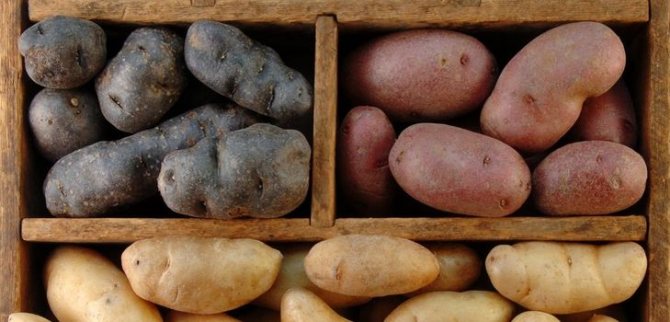

It acquires an uncharacteristic sweetish aftertaste. Sometimes this can be corrected by keeping such tubers in the room for several days.
There is a process of first transformation of starch into sugar - in the cold. The opposite happens in the room. Perhaps this is only on tubers that are not damaged by frost.
The resulting stains have a rust-like color. There are many of them, the size from small - millimeter, up to 2 cm.
With the development of the lesion, the color changes not only parallel to the peel. Merged, becoming large, spots appear in the thickness of the tuber.
This disease of potatoes is interesting in that the tubers do not rot. They remain firm even during cooking.
Another characteristic rare feature. Tubers are stored without spoilage, left for seeds, will give normal plants when grown.
New tubers will not show signs of rust under good (agrotechnical) conditions.
There is still a scientific debate about the causes of glandular spotting. Some believe that soil potassium deficiency is to blame, others - phosphorus.
Still others blame an excess of aluminum in the soil substrate. There are many versions. An increased manifestation of this disease has been noticed in dry, abnormally hot years.
There is even a version of the viral etiology of this potato disease.
We offer you to familiarize yourself with: How to make money on your greenhouse
Preventive control measures:
- Sowing after leguminous green manure restrains the development of the disease;
- Application of nitrogen fertilizers;
- Prevention of soil overheating. This is an assistant - watering, it is good to connect sprinkling.
There are no external manifestations, a nuisance is found when cutting a potato. The hollows are leathery (skinned).
They arise from the excessive intensity of tissue growth. Therefore, hollowness can often be found in large potatoes.
The hollow is not affected by pathogenic flora if it is completely enclosed inside the tuber.
Hollowness can be caused by:
- Excessive burial of seed on dense soils.
- An imbalance in nutrition for the main elements (NPK), especially an overabundance of the first - nitrogen. Nitrogen stimulates a rapid build-up of mass, tissues compete - which one will have time faster, and they crack inside into hollows.
- Unreasonably frequent watering or prolonged rainy weather.
- Large distances between planted potato bushes.
Anything that spurs rapid growth can provoke hollowness.
For prevention, observe moderation, do not feed the potatoes, do not cherish them like an only child.
Just try to stay on optimal conditions for this culture.
Why does the potato turn black inside
Potatoes are a very popular vegetable in Russia; almost every gardener grows it. But it is important not only to get a large harvest, but also to preserve it. The most common problem in this case is that the tubers turn black inside. Sometimes even normal-looking vegetables have dark spots in the cut.
Important! Medium-sized ripe tubers are stored for the longest.
It is necessary to timely identify the reason why the tubers begin to turn black inside during storage and eliminate it, otherwise the entire crop may be destroyed. Such signs can be caused both by the physiological disease melanosis or, in another way, gray spot, and by various infectious diseases caused by fungi.
Unfavorable weather conditions
Potatoes grow well in moderate humidity and temperature. If these indicators change, then this negatively affects the yield and keeping quality of tubers:
- at high temperatures, the vegetable overheats;
- at low temperatures, potatoes grow small due to lack of nutrients;
- with a lack of watering, the culture is dried;
- with an excess of moisture, oxygen poorly enters the tubers, provoking the development of bacterial and fungal infections.
All these conditions, individually or in combination, can lead to the fact that the vegetable begins to turn black inside. Thus, the product loses its consumer qualities.
Incorrect fertilization
Some gardeners, in pursuit of large yields, fertilize vegetable crops with too much organic matter. Herbal infusions, manure or green manure are used. These fertilizers promote plant growth due to their high nitrogen content. But during storage, such overfed tubers begin to blacken inside.
To avoid spoilage of potatoes after harvest, you need to fertilize them according to the rules:
- fresh organic fertilizers are not used, only rotted;
- manure is rarely applied - once every 2 years.
There is often an excess of nitrogen and a lack of potash fertilizers in the soil. Namely, potassium contributes to the long-term storage of potatoes. Without it, he can begin to turn black.
Mechanical damage to tubers
Potatoes can also turn black inside due to mechanical damage that occurs during collection or transportation. The deformed parts of the potato subsequently change color. And if the skin is damaged, then there is a great risk of fungi and bacteria entering the vegetable.
Potatoes turn black on the inside during storage also when they are placed in several layers. The tubers lying below are under strong pressure.
Infectious diseases
The appearance of characteristic dark spots inside the tubers is usually accompanied by diseases such as:
- Blackleg. A disease called black leg affects the tops and tubers of potatoes. Its first symptoms appear during storage of the crop. It is a rot, which inside reaches the center of the tubers, and they begin to turn black. Outwardly, it can be distinguished from gray spot. The whole fruit is affected, starting to exude an unpleasant odor. Potatoes lying nearby are also susceptible to infection. It is important to identify the disease at the stage of cultivation in order to prevent such vegetables from entering the storage.
- Late blight. The disease is common in almost all climates where potatoes are grown. Both tops and tubers are affected. The fungus spreads quickly, damaging all plants. Brown specks appear on the leaves, they rot and dry out. The disease is transmitted through weeds, progresses when the agricultural technology of potato cultivation is violated. The tubers affected by late blight are covered with brown spots from the inside. High temperature contributes to the development of the fungus. Potatoes are infected during harvesting or from their own diseased tops. The likelihood of transmission from an adjacent tuber during storage is minimal. Late blight can also provoke diseases with other fungi.
Improper storage
The storage of the potato crop is carried out in a basement with a temperature from +1 to +4 ° C. If the indicator drops below, then the tubers become sweet and begin to turn black inside. At higher temperatures, potatoes will sprout and the risk of gray rot increases.
Late cleaning
Timely harvesting of potatoes is the key to preserving the harvest. To prevent the tubers from starting to blacken inside, adhere to the following rules:
- When harvesting potatoes, one must be guided by varietal characteristics - a crop harvested too early is likely to turn black inside during storage. The tubers must mature naturally.
- Harvesting must be done before the first frost. If you leave potatoes in the ground at a temperature of -1 ° C, they will freeze and then rot during storage.
- After the tops have been mowed, the tubers must be harvested as soon as possible. If warm weather starts, the vegetable may overheat.
- The harvested potatoes are stored in a dry, well-ventilated room at a temperature of +4 ° C.
Harvesting potatoes in a timely manner reduces the likelihood that the tubers will begin to blacken inside during storage.
Prevention of blackening
The lesion is wet and dry, odorless or odorless. In some cases, potatoes contain white or grayish fungal spores. Sometimes not only tubers but also tops are blackened. The leaves and stems are covered with dark spots that quickly spread throughout the plant.
- Choose more disease resistant varieties. Give preference to those adapted to the climatic and soil conditions of a particular region.
- Carry out pre-sowing treatment of tubers with special preparations (Immunocytophyte, Prestige, Quadris, Maxim or others). They enhance the planting material and reduce the risk of infection.
- Stick to crop rotation - if this requirement is not observed, root crops have every chance of being affected by diseases of other crops, which pose a threat to potatoes.
- After harvesting, remove tops and other vegetation from the area. Weed the weeds regularly throughout the season. When the first signs of the disease appear, carry out preventive treatment of all plants.
Browning of potatoes is common. But if you adhere to all, without exception, conditions for growing and storing crops, selecting varieties with a sufficient starch content and resistance to major diseases, then you can minimize the threat of a problem.
- How to plant potatoes correctly to get a good harvest
- Brown spots on violet leaves: causes, treatment. Violet leaf spots: causes and elimination
- Why do thuja turn yellow: causes, treatment and prevention
- Green tomatoes with garlic inside for the winter
What to do to prevent the potatoes from turning black
Very often there are situations when the potatoes lay in the basement all winter, and by the spring they began to turn black. This could be due to poor ventilation.
With warming, the potatoes will melt into storage and germinate. The pulp darkens and becomes lethargic. There is a sharp jump in temperatures, the release of moisture and the debate continues. Thus, you can lose the entire crop.
To prevent the potatoes from turning black inside during storage, a number of rules must be followed:
- after harvest, the potatoes should be kept outdoors for 20 days;
- place it in wooden boxes with ventilation holes;
- maintain the required temperature in the storage;
- boxes and pallets should be moved 20 cm away from the walls;
- potatoes are sorted at least once - sprouted and diseased tubers, as well as healthy ones located next to them, are removed;
- if storage is carried out at home on the balcony, then it is recommended to cover the boxes with a warm blanket;
- potatoes can only be stored together with beets, which will take away excess moisture from them; proximity to other vegetables is strictly prohibited.
Storage rules
How long the potatoes will last depends on the correct preparation for storage and the conditions in the cellar itself. The choice of variety when planting also affects. The main factors that must be taken into account for the safety of the crop:
- When planting, you need to think about which varieties are needed, because they are stored in different ways. Late potatoes are intended for long-term storage in the cellar. Early varieties will not last long even under ideal conditions. They are intended to be eaten directly in season.
- Before being sent for storage, the tubers are sorted and sorted - diseased, damaged, and suspicious ones are removed. Potatoes that come into contact with diseased vegetables should also be removed, they may be contaminated, but the symptoms have not yet appeared. Even a few diseased tubers can destroy the entire crop in storage. Be sure to dry the potatoes, otherwise raw tubers may turn black inside and rot.
- Constant monitoring of the temperature at the place of storage of the crop is required. Special control is needed in the change of seasons in autumn and winter, when there is a risk of temperature surges.
Important! Some varieties of potatoes contain a lot of starch and a slight browning is normal for them.
To maintain the desired air temperature in the storage, ventilation, bottles with cold or hot water, placed around the perimeter of the cellar, are used. Thus, the risk that the vegetable will begin to turn black inside is reduced. With timely control of humidity and temperature indicators, potatoes can be preserved.
Tips & Tricks
If possible, observe the crop rotation on the site. It is undesirable to plant the same vegetable crop in some area every year.... Constant sowing of one plant depletes the soil, reduces fertility. Infection with bacteria only makes the situation worse. Let the site rest for 1 to 2 years. During this time, disinfect the soil and fertilize it.
Early varieties are more susceptible to ring rot infestations... Choose medium or late.
Regular weeding, destruction of pests and the affected bushes will benefit the potatoes.
To protect the vegetable from diseases, start treatment with drugs at the first signs of the disease.... In dry weather, perform the procedure every 14 days, in rainy weather every week or even more often. Without treatment, infections are capable of destroying 40-50% of the crop.
It is useful to know how the neighbors are dealing with plant diseases. If the sites are located nearby, contamination of your vegetable crops is also possible.

